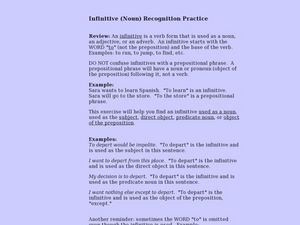Curated OER
Subject Pronouns in Spanish
Starting off with examples and explanations of English subjects and pronouns, this resource explores Spanish subject pronouns in great detail. Each subject pronoun is described and paired with examples. Additionally, the material...
Curated OER
Negative Words & Expressions in Spanish
You don't never use double negatives in English, but the grammar is slightly different in Spanish. Help your class grasp this concepts and pick up how to compose sentences that are negative, rather than affirmative with the information...
Curated OER
Spanish Sentence Construction
After reviewing Spanish articles, nouns, noun gender, subject pronouns, and the verb ser, give your emerging Spanish speakers this practice packet. Several activities are included: an unscrambling exercise, translation practice, an...
Curated OER
Online Spanish Lesson on Superlatives: General Rules
How much does your class know about superlatives? Inform them of the basics and provide some practice with the information here. You can use the examples to help teach the concepts in class or send learners to this page at home. The...
Curated OER
Direct & Indirect Object Pronouns
There is a wealth of information provided here about direct and indirect object pronouns. Consider breaking these complex grammatical concepts into smaller chunks so that your Spanish language learners do not become overwhelmed. The At a...
K12 Reader
Comparative & Superlative Practice
When should you use more and most when writing adverbs? Practice comparative and superlative adverbs with a review worksheet. After reading through the information at the top of the page, kids decide if they should use the...
Curated OER
The Personal a
Introduce your Spanish class to the personal a, used when the direct object is a person or personified thing. You can show the provided presentation first and direct them to the other two tabs on this webpage for reference and additional...
Curated OER
Negative/Affirmative Words
Do you play any sports? Listed here are a series of yes-or-no questions to get your Spanish class practicing using either negative or affirmative words to answer questions. The answer is already partially written out, so consider...
Curated OER
Infinitive (Noun) Recognition Practice
In this noun infinitives practice worksheet, students read an informative lesson. Students then respond to 15 questions that require them to identify the infinitives in each sentence and label them as subject, direct object, predicate...
Curated OER
Indefinite Pronouns
How do you use indefinite pronouns in the Spanish language? After introducing your language learners to indefinite pronouns, provide them with this practice opportunity. They read the sentence provided and choose the indefinite pronoun...
Curated OER
Reflexive Verbs
Reflexive verbs and pronouns are a breeze with this reference guide! Explanations and examples are provided, and the chart is well-organized for easy understanding. Now provide your learners with an opportunity to put this knowledge to...
Curated OER
Direct Objects
Your Spanish language learners can identify nouns and verbs, but can they identify the direct object of a sentence? Give them this practice opportunity to find out! There are 32 sentences, and the pupil must correctly identify the direct...
Curated OER
Preterite vs. Imperfect #5
What is the imperfect tense or a Spanish preterite? After reviewing the tense and its conjugation with your intermediate Spanish class, provide them several opportunities to practice. Here's one that'd be the perfect bell-ringer...
Rock A Lingua
Medios de Transporte/Means of Transportation
Make sure your pupils know how to get where they want to go! Learners can practice their Spanish vocabulary by completing these worksheets, which focus on modes of transportation and some grammar phrases for expressing going from one...
Curated OER
Grammar Practice
In this grammar instructional activity, students complete problems on editing sentences, analogies, plurals, grouping words, and proper nouns. Students complete 5 problems.
Curated OER
Less vs. Fewer
When should you use less, and when should you use fewer? Straighten out this dilemma with a helpful resource about using less vs. fewer based on sentence context clues. After reading detailed instructions and examples, young learners...
Curated OER
Present Tense: Irregular Verbs
Make verb conjugation second nature to your beginning Spanish speakers. This short, 10-question practice opportunity focuses on irregular verbs in the present tense. After your class completes the sheet, have them partner up for some...
Curated OER
Por vs. Para #2
Is your class having trouble distinguishing between when to use the Spanish word por or para? Print this half-sheet to give them some practice! They complete the 10 blank spaces with either word to complete the sentence.
Curated OER
Preterite vs. Imperfect #10
Compile a packet of practice worksheets for your beginning Spanish speakers learning about expressing actions in the past tense and using preterite verbs. Simply search more worksheets for preterite and imperfect tenses to add resources!
Curated OER
Direct and Indirect Object Pronouns #1
Review direct and indirect object pronouns with this practice activity. Sure, it's easy to use one or the other, but can your beginning Spanish language learners use both in sentence correctly? Give them this informal assessment to find...
Curated OER
Ser vs. Estar #2
Ser and estar are such similar verbs; it's easy to confuse the two! Give your beginning Spanish speakers lots of practice conjugating the two. This instructional activity provides 10 sentences, and the learner has to complete each one...
Curated OER
Imperative #1: Formal, Informal, and Uds. commands
Estudie esto! Are you reviewing formal and informal commands? Use this sheet for quick practice, and then have learners pair up and practice saying the commands aloud.
Curated OER
Ser vs. Estar #1
What are the differences between ser and estar? Start by discussing the differences, showing your class how to conjugate each, and doing some examples together. Then, give them some practice!
Curated OER
Ser vs. Estar #3
Ah, ser and estar are at it again! When do you use each verb? Discuss the function of each, and then give your class this practice opportunity to assess their growing knowledge.

























